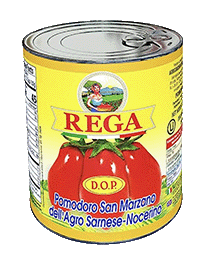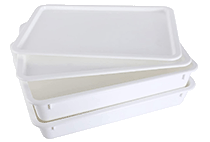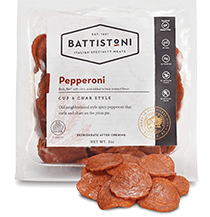Naples, the birthplace of pizza, has given the world Neapolitan pizza, which is considered true Italian pizza. Over time, as more people fell in love with pizza, pizza crossed the ocean and made its way into the U.S., where pizza changed and evolved.
Many new styles of pizza were born in America, but the original Neapolitan pizza stayed true and has remained the same even while New York-style, Chicago-style deep dish, Detroit-style, and St. Louis-style all became popular forms of pizza.
True Neapolitan pizza kept its district style that diners all over Italy adored. You can learn how to make Neapolitan pizza at home and impress your friends and family on your next pizza night with true Italian pizza.
Key Takeaways:
- Neapolitan pizza is a style of pizza that is made with 00 flour, fresh San Marzano tomatoes, fresh mozzarella cheese, fresh basil, and extra virgin olive oil. It is cooked at extremely high temperatures, between 800 to 900º F, and for a short 90 seconds.
- To be a certified Neapolitan pizza maker, you must be authorized by the Italian Associazione Verace Pizza Napoletana (VPN), which certifies pizzerias that use the proper artisan method, ingredients, and traditions of authentic Neapolitan pizza.
- Making Neapolitan pizza at home is possible, but ideally, you need a pizza oven. The high heat is essential to getting a fast-cooked crust and making the whole thing come together from crust to melted cheese to cooking the fresh tomato sauce just right so it’s hot enough but still keeps the fresh flavor.
Table of Contents

What is a Neapolitan Pizza?
Neapolitan pizza is a style of pizza that is made with 00 flour, fresh San Marzano tomatoes, fresh mozzarella cheese, fresh basil, and extra virgin olive oil. There isn’t any pepperoni, sausage, mushrooms, or all of the other goodies that you would find at your local pizzeria.
Neapolitan pizzas are cooked at extremely high temperatures, between 800 to 900º F, and for a short 90 seconds. The result is a flash-cooked pizza with a nice char on the edges called leopard crust and a wet middle.
These pizzas are more sauce than cheese, making the middle a little soupy in the best way. You won’t find a large or family-sized Neapolitan pizza they are always on the smaller side, like 10 to 12 inches at the most, and they are never served by the slice.
While some pizzerias claim to make Neapolitan pizza, they aren’t true Neapolitan pies because to be a certified Neapolitan pizza maker, you must be authorized by the Italian Associazione Verace Pizza Napoletana (VPN). We hope to be certified ourselves someday.
The organization certifies pizzerias that use the proper artisan method, ingredients, and traditions of authentic Neapolitan pizza. The organization was founded in 1984 in Naples to protect the integrity of Neapolitan pizzas.
For pizzerias to become certified, they must officially apply and prove that they are following the set protocol to make Neapolitan pizza. It is a time-consuming process that many pizzerias choose not to follow and instead just say they a Neapolitan.
Currently, only a few hundred establishments in Italy and around the world are actually VPN-certified. In Naples, pizza is serious business, and they don’t want their reputation ruined by bad pizza.
Requirements for A True Neapolitan Pizza
The official requirements to make a Neapolitan pizza are fairly straightforward and start with the pizza dough. The dough must be made with Italian type 0 or 00 wheat flour. This flour is fine, like baby powder.
Next is the yeast. Instead of dry yeast, which is what most home pizzaiolos use, Neapolitan requires fresh brewer’s yeast. Then the dough must be kneaded by hand and formed without a rolling pin.

After the dough is shaped and formed by hand, then it’s time for the sauce. The sauce is made from crushed San Marzano tomatoes from Italy. The cheese must be either fior di latte made from cow’s milk, or mozzarella di Bufala, made from water buffalo milk. The pizza is finished with freshly torn basil leaves and extra virgin olive oil.
So from the dough to the cheese to the tomatoes, there are quite a few rules to make this classic pizza. So it’s easy to understand why some pizzerias choose not to get the certification. San Marzano tomatoes are amazing, but they can be expensive for a small local pizzeria.
And not everyone likes to work with 00 flour on a large scale. The powdery flour can cause health issues from inhaling it as it flies around while making pizza.
Three Certified Forms of Neapolitan Pizza
There are three forms of Neapolitan pizza that are considered true Neapolitan and accepted by the VPN.
Marinara
Tomato, garlic, oregano, and extra virgin olive oil.
Pizza Margherita
Tomato, fresh sliced mozzarella, fresh basil, and extra-virgin olive oil.
Pizza Margherita Extra
Tomato, sliced mozzarella di Bufala, fresh basil, and extra-virgin olive oil.
Don’t tell the pizza snobs or the pineapple stans, their options are really limited by the Neapolitan pizza overlords.
History of Neapolitan Pizza
The history of pizza goes back to when Persian soldiers were heating unleavened bread on a hot rock. But as pizza evolved and cheese was introduced to southern Italy courtesy of the Arabs and their water buffalo and later tomatoes hit the scene courtesy of South America, the process became more complex, and the modern pizza was born.
Originally in Naples, pizza was poor man’s food. It was for the working class to eat the streets on their way to and from work. But later, it evolved even more, and thanks to a visit by King Umberto I and Queen Margherita of Savoy in 1889, the Neapolitan pizza gained some recognition, and the rest is delicious history.
Note: this style of pizza is very different from Roman style pizza founded in Rome.
How to Make Neapolitan Pizza at Home

Making Neapolitan pizza at home is possible, but ideally, you need a pizza oven. Pizza ovens reach extremely high temperatures, and a home oven usually only reaches 500º F.
The high heat is essential to getting a fast-cooked crust and making the whole thing come together from crust to melted cheese to cooking the fresh tomato sauce just right so it’s hot enough but still keeps the fresh flavor.
Once you have a nice pizza oven set up, then comes the trial and error process. We wish we could just give you a recipe and say it’s that easy, but pizza is an art form, and like anything in the arts, it takes some time to master.
There are some great pizza Facebook groups dedicated to Neapolitan pizza and home pizzaiolos sharing their pizza knowledge. So if you’re looking to focus just on Neapolitan, then these groups are an excellent option as you master the art of Neapolitan pizzas.
The Neapolitan Pizza Sauce
Neapolitan pizza sauce is a little chunky. The tomatoes are hand squeezed instead of put in a blender so they still have a little texture. Combine all of the ingredients in a bowl and mix.
Pro Tip: Make sure to drain the liquid from the can so the sauce isn’t too wet.
- 1 14 ounce can San Marzano tomatoes
- 1 Tablespoon extra virgin olive oil
- 1 teaspoon sea salt
- 1 teaspoon dried oregano
- ¼ teaspoon of crushed red pepper
The Neapolitan Pizza Dough
- 2 ½ cups of water
- 4 ½ cups of 00 flour
- 2 Tablespoons sea salt
- ½ teaspoon of brewer’s yeast (if you can’t find authentic yeast, just use active dry yeast.)
Mix ingredients together. Knead until smooth. Place in an oiled bowl and cover for two hours. Next, divide the dough into dough balls by pinching and tucking. Place dough balls in an airtight-proofing container in the refrigerator for 24 hours.
Take the dough balls out an hour before you are ready to make pizza. Stretch the dough and form small pizza rounds. Cover with sauce and cheese. Bake at the highest setting in your pizza oven for 90 seconds. Post-baking, add basil leaves and extra virgin olive oil.
If you have never had Neapolitan pizza before, here is a map with the certified VPN pizzerias in every state to help you get inspired.
Have you made Neapolitan pizza at home before? And when are you going to get Neapolitan certified?













